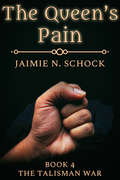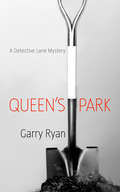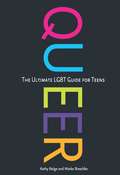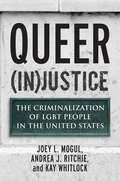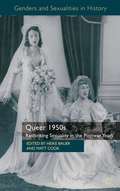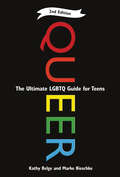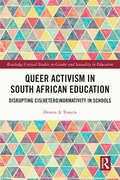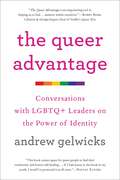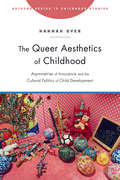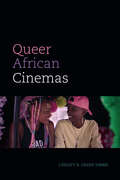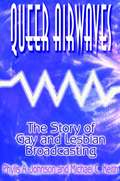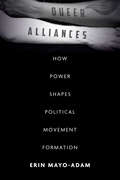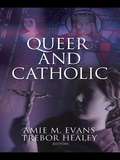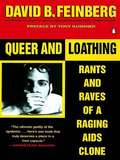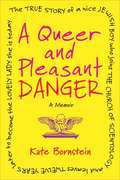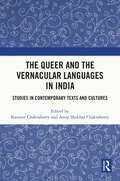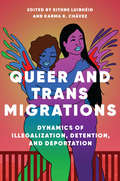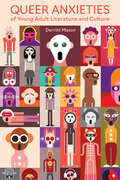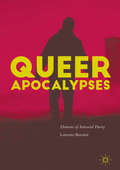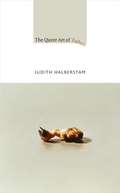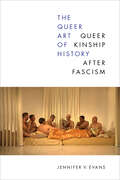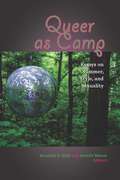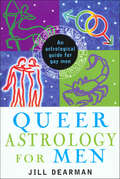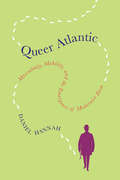- Table View
- List View
The Queen's Pain
by Jaimie N. SchockSequel to The Circus CrownKenna Crossley now runs the town of New Somerset. She is responsible for its food, its electricity, and most importantly, its protection. She will defend it with her life if necessary, in order to keep its citizens -- including her ailing father Dakota -- safe from harm.But the appearance of a strange, deformed animal puts everything Kenna has worked for at risk. Soon the mountains surrounding their little town are overrun with bloodthirsty creatures. As Kenna fights them and builds up barriers around the town, she begins to suspect it's a losing battle.Can Kenna protect New Somerset, or will the mutated monsters win? And who among them will survive?
Queen's Park: A Detective Lane Mystery (Detective Lane Series #1)
by Garry RyanDetective Lane has a knack for discovering the whereabouts of missing persons. But the city's latest case has disappeared without a trace. After a brutal attack on his young nephew, ex-mayor Bob Swatsky has gone missing with 13 million dollars of taxpayer's money. Is he on the run with the cash, or is it something more sinister? A zany cast of characters, including a love doll and a chain-smoking grandma with an oxygen tank, lead Detective Lane on a thrilling romp through the streets of Calgary. The chase is on, and alone, Lane must uncover the truth before someone ends up visiting Queen's Park cemetery... permanently.
Queer: The Ultimate LGBT Guide for Teens
by Christian Robinson Kathy Belge Marke BieschkeTeen life is hard enough with all of the pressures kids face, but for teens who are LGBT (lesbian, gay, bisexual, or transgender), it's even harder. When do you decide to come out? To whom? Will your friends accept you? And how on earth do you meet people to date? Queer is a humorous, engaging, and honest guide that helps LGBT teens come out to friends and family, navigate their new LGBT social life, figure out if a crush is also queer, and rise up against bigotry and homophobia. Queer also includes personal stories from the authors and sidebars on queer history. It's a must-read for any teen who thinks they might be queer--or knows someone who is.
Queer: The Criminalization of LGBT People in the United States (Queer Ideas/Queer Action #5)
by Kay Whitlock Joey Mogul Andrea RitchieA groundbreaking work that turns a "queer eye" on the criminal legal system Drawing on years of research, activism, and legal advocacy, Queer (In)Justice is a searing examination of queer experiences--as "suspects," defendants, prisoners, and survivors of crime. The authors unpack queer criminal archetypes--like "gleeful gay killers," "lethal lesbians," "disease spreaders," and "deceptive gender benders"--to illustrate the punishment of queer expression, regardless of whether a crime was ever committed. Tracing stories from the streets to the bench to behind prison bars, the authors prove that the policing of sex and gender both bolsters and reinforces racial and gender inequalities. A groundbreaking work that turns a "queer eye" on the criminal legal system, Queer (In)Justice illuminates and challenges the many ways in which queer lives are criminalized, policed, and punished. streets and behind prison bars, the authors prove that the policing of sex and gender both bolsters and reinforces racial and gender inequalities.
Queer 1950s: Rethinking Sexuality in the Postwar Years
by Heike Bauer Matt CookThis collection brings together scholars from across the humanities in a fresh examination of queer lives, cultures and thought in the first full post-war decade. Through explorations of sexology, literature, film, oral testimony, newspapers and court records it nuances understandings of the period, and makes a case for the particularity of queer lives in different national contexts from Finland to New Zealand, the UK to the USA - whilst also marking the transnational movement of people and ideas. The collection rethinks perceptions of the 1950s, traces genealogies of sexual thought in that decade, and pinpoints some of its legacies. In so doing, it explores the utility of queer theoretical approaches and asks how far they can help us to unpick queer lives, relationships and networks in the past. "
Queer, 2nd Edition: The Ultimate LGBTQ Guide for Teens
by Kathy Belge Marke BieschkeTeen life is hard enough, but for teens who are LGBTQ, it can be even harder. When do you decide to come out? Will your friends accept you? And how do you meet people to date? Queer is a humorous, engaging, and honest guide that helps LGBTQ teens come out to friends and family, navigate their social life, figure out if a crush is also queer, and challenge bigotry and homophobia. Personal stories from the authors and sidebars on queer history provide relatable context. This completely revised and updated edition is a must-read for any teen who thinks they might be queer or knows someone who is. "A delightful collection of trustworthy and accurate information that tweens and teens need today, all told in a sort of quirky, sometimes goofy, and always approachable tone...a fun, easy to read, and occasionally hilarious guide that should be available on a shelf in every high school library." —Diane Anderson-Minshall, Editorial Director, The Advocate magazine "Not every queer kid has easy access to a family member, teacher, counselor, or friend who can help them through the coming-out process. Even when they do, NEWSFLASH, most of us don't have all the answers! Queer is a great way for a teen, or someone who is trying to mentor or understand a queer teen, to gain some knowledge from a thoughtful, cute perspective."—Honey Mahogany, Activist, RuPaul's Drag Race Alumnus, Cofounder of the Compton's Transgender Cultural District "I learned more than a few things about our fabulously diverse queer culture, and especially the younger generation, that everyone should know."—Terry Beswick, Executive Director of the GLBT Historical Society Archives and Museum
Queer Activism in South African Education: Disrupting Cis(hetero)normativity in Schools (Routledge Critical Studies in Gender and Sexuality in Education)
by Dennis A. FrancisOffering a vital, critical contribution to debates on gender, sexuality and schooling in South Africa, this book highlights how South African educational practices, discourses and structures normalize cisheteronormativity, along with how these are resisted within schools and through contemporary forms of activism. Not only does it add fresh insights to the existing research literature on gender, sexualities and schooling, it also underscores the valuable contributions of queer and transgender social movements, which have made influential legislative, teaching, learning and support contributions to education. Drawing on ethnographic research with queer and transgender activists, teachers, school managers, parents and school attending youth, the book provides everyday real-life quotes and observations offering a deeply critical contribution to the debates on gender and sexualities, education and activism. Using spatial and affect theories, it troubles the assumptions that frame this field of research to make a novel contribution to the national and international literature and research. The book provides research-based insights for thinking about and calls for informed action to challenging cisheteronormativity within and beyond schools.
The Queer Advantage: Conversations with LGBTQ+ Leaders on the Power of Identity
by Andrew GelwicksMeet the LGBTQ+ dealmakers, trailblazers, and glass-ceiling breakers in business, politics, and beyond.The people who are creating national public policy, running billion-dollar tech enterprises, and winning Olympic medals. Andrew Gelwicks interviews the leaders who have forged their own paths and changed the world. From Troye Sivan to Margaret Cho, George Takei to Billie Jean King, Shangela to Adam Rippon, each person credits their queer identity with giving them an edge in their paths to success. Their stories brim with the hard-won lessons gained over their careers. With variances in age, background, careers, and races, key themes shine through: Channeling anger in a positive way -- using it as rocket fuel to succeedLeveraging your difference to beget new ideas and strategiesBridging generational gapsAccessing resources to conquer crippling denial, internalized homophobia, and doubtThe power of the Internet as a tool of self-discoveryUsing your sensitivity and attunement to read the room, deciding when to fit in and when to stand outFinding a queer tribe and learning to help and lean on one anotherCollecting incisive, deeply personal conversations with LGBTQ+ trailblazers about how they leveraged the challenges and insights they had as relative outsiders to succeed in the worlds of business, tech, politics, Hollywood, sports and beyond, The Queer Advantage celebrates the unique, supercharged power of queerness.
The Queer Aesthetics of Childhood: Asymmetries of Innocence and the Cultural Politics of Child Development (Rutgers Series in Childhood Studies)
by Hannah DyerIn The Queer Aesthetics of Childhood, Hannah Dyer offers a study of how children’s art and art about childhood can forecast new models of social life that redistribute care, belonging, and political value. Dyer suggests that childhood’s cultural expressions offer insight into the persisting residues of colonial history, nation building, homophobia, and related violence. Drawing from queer and feminist theory, psychoanalysis, settler-colonial studies, and cultural studies, this book helps to explain how some theories of childhood can hurt children. Dyer’s analysis moves between diverse sites and scales, including photographs and an art installation, children’s drawings after experiencing war in Gaza, a novel about gay love and childhood trauma, and debates in sex-education. In the cultural formations of art, she finds new theories of childhood that attend to the knowledge, trauma, fortitude and experience that children might possess. In addressing aggressions against children, ambivalences towards child protection, and the vital contributions children make to transnational politics, she seeks new and queer theories of childhood.
Queer African Cinemas (a Camera Obscura book)
by Lindsey B. Green-SimmsIn Queer African Cinemas, Lindsey B. Green-Simms examines films produced by and about queer Africans in the first two decades of the twenty-first century in an environment of increasing antiqueer violence, efforts to criminalize homosexuality, and other state-sanctioned homophobia. Green-Simms argues that these films not only record the fear, anxiety, and vulnerability many queer Africans experience; they highlight how queer African cinematic practices contribute to imagining new hopes and possibilities. Examining globally circulating international art films as well as popular melodramas made for local audiences, Green-Simms emphasizes that in these films queer resistance—contrary to traditional narratives about resistance that center overt and heroic struggle—is often practiced from a position of vulnerability. By reading queer films alongside discussions about censorship and audiences, Green-Simms renders queer African cinema as a rich visual archive that documents the difficulty of queer existence as well as the potentials for queer life-building and survival.
Queer Airwaves: The Story of Gay and Lesbian Broadcasting
by Phylis W Johnson Michael C KeithThis book is both a retrospective history of the gay community's use of electronic media as a way of networking and creating a sense of community, and an examination of the current situation, an analysis and critical assessment of gay/lesbian electronic media. Keith and Johnson use original interviews and oral history to delineate the place of electronic media in the lives of this increasingly visible and vocal minority in America.
Queer Alliances: How Power Shapes Political Movement Formation
by Erin Mayo-AdamA unique investigation into how alliances form in highly polarized times among LGBTQ, immigrant, and labor rights activists, revealing the impacts within each rights movement. Queer Alliances investigates coalition formation among LGBTQ, immigrant, and labor rights activists in the United States, revealing how these new alliances impact political movement formation. In the early 2000s, the LGBTQ and immigrant rights movements operated separately from and, sometimes, in a hostile manner towards each other. Since 2008, by contrast, major alliances have formed at the national and state level across these communities. Yet, this new coalition formation came at a cost. Today, coalitions across these communities have been largely reluctant to address issues of police brutality, mass incarceration, economic inequality, and the ruthless immigrant regulatory complex. Queer Alliances examines the extent to which grassroots groups bridged historic divisions based on race, gender, class, and immigration status through the development of coalitions, looking specifically at coalition building around expanding LGBTQ rights in Washington State and immigrant and migrant rights in Arizona. Erin Mayo-Adam traces the evolution of political movement formation in each state, and shows that while the movements expanded, they simultaneously ossified around goals that matter to the most advantaged segments of their respective communities. Through a detailed, multi-method study that involves archival research and in-depth interviews with organization leaders and advocates, Queer Alliances centers local, coalition-based mobilization across and within multiple movements rather than national campaigns and court cases that often occur at the end of movement formation. Mayo-Adam argues that the construction of common political movement narratives and a shared core of opponents can help to explain the paradoxical effects of coalition formation. On the one hand, the development of shared political movement narratives and common opponents can expand movements in some contexts. On the other hand, the episodic nature of rights-based campaigns can simultaneously contain and undermine movement expansion, reinforcing movement divisions. Mayo-Adam reveals the extent to which inter- and intra-movement coalitions, formed to win rights or thwart rights losses, represent and serve intersectionally marginalized communities—who are often absent from contemporary accounts of social movement formation.
Queer and Catholic
by Amie Evans Trebor HealeyHow does one reconcile the tension between the community of one’s own Catholic upbringing and a sexuality and gender identity that may be in conflict with some of the tenets of the faith – especially when one is a member of the Gay, Lesbian, Bisexual, Transgender, Queer, and Intersex community? Queer and Catholic offers a source of comfort to members of these communities, focusing on not only practicing Catholics, but also the entire experience of growing up Catholic. This unique book discusses Catholicism beyond its religiosity and considers its implications as a culture of origin. This widely varied and entertaining book pulls together a comprehensive collection of essays, stories, and poetry that together represent an honest and engaging reflection of being a queer person within the Catholic experience.
Queer and Loathing: Rants and Raves of a Raging AIDS Clone
by David B. Feinberg Tony Kushner"This is as close to the truth as I can get, " writes David B. Feinberg in this stunning nonfiction debut - a collection of autobiographical essays, gonzo journalism, and demented Feinbergian lists about AIDS activism and living, writing, and dying with AIDS. With the startling blend of satiric wit and pathos, black humor and heroism, found in his widely acclaimed and iconoclastic novels, he charts a harrowing personal journey down that "HIV highway to hell."
A Queer and Pleasant Danger: The True Story of a Nice Jewish Boy Who Joins the Church of Scientology and Leaves Twelve Years Later to Become the Lovely Lady She Is Today
by Kate BornsteinA stunningly original memoir of a nice Jewish boy who joined the Church of Scientology and left twelve years later, ultimately transitioning to a woman. A few years later, she stopped calling herself a woman and became famous as a gender outlaw. Kate Bornstein-gender theorist, performance artist, author-is set to change lives with her compelling memoir. Wickedly funny and disarmingly honest, this is Bornstein's most intimate book yet, encompassing her early childhood and adolescence, college at Brown, a life in the theater, three marriages and fatherhood, the Scientology hierarchy, transsexual life, LGBTQ politics, and life on the road as a sought-after speaker.
The Queer and the Vernacular Languages in India: Studies in Contemporary Texts and Cultures
by Kaustav Chakraborty Anup Shekhar ChakrabortyThis book analyses regional expressions of the queer experience in texts available in the Indian vernacular languages. It studies queer autobiographies and literary and cinematic texts written in the vernacular languages on gay, lesbian, bisexual and transgender issues. The authors outline the specific terms that are popular in the bhashas (languages) to refer to the queer people and discuss any neo coinages/modes of communication invented by the queer people themselves. The volume also addresses the lack of queer representation in certain language communities and the lack of queer interaction in non-metropolitan cities in India. An important contribution to the field of queer studies in India, this timely book will be an essential read for scholars and researchers of gender studies, queer studies, cultural studies, discrimination and exclusion studies, language studies, political studies, sociology, postcolonial studies and South Asian studies.
Queer and Trans Migrations: Dynamics of Illegalization, Detention, and Deportation (Dissident Feminisms)
by Andrew J. Brown Julio Capo Anna Carastathis Jack Caraves Karma R. Chavez Ryan Conrad Elif Katherine Fobear Monisha Das Gupta Jamila Hammami Edward Ou Lee Leece Lee-Oliver Eithne Luibheid Hana Masri Yasmin Nair Bamby Salcedo Fadi Saleh Rafael Ramirez Solorzano José Guadalupe Soto Myrto Tsilimpounidi Suyapa Portillo Villeda Sasha Wijeyeratne Ruben ZecenaMore than a quarter of a million LGBTQ-identified migrants in the United States lack documentation and constantly risk detention and deportation. LGBTQ migrants around the world endure similarly precarious situations. Eithne Luibhéid's and Karma R. Chávez’s edited collection provides a first-of-its-kind look at LGBTQ migrants and communities. The academics, activists, and artists in the volume center illegalization, detention, and deportation in national and transnational contexts, and examine how migrants and allies negotiate, resist, refuse, and critique these processes. The works contribute to the fields of gender and sexuality studies, critical race and ethnic studies, borders and migration studies, and decolonial studies. Bridging voices and works from inside and outside of the academy, and international in scope, Queer and Trans Migrations illuminates new perspectives in the field of queer and trans migration studies. Contributors: Andrew J. Brown, Julio Capó, Jr., Anna Carastathis, Jack Cáraves, Karma R. Chávez, Ryan Conrad, Elif, Katherine Fobear, Monisha Das Gupta, Jamila Hammami, Edward Ou Jin Lee, Leece Lee-Oliver, Eithne Luibhéid, Hana Masri, Yasmin Nair, Bamby Salcedo, Fadi Saleh, Rafael Ramirez Solórzano, José Guadalupe Herrera Soto, Myrto Tsilimpounidi, Suyapa Portillo Villeda, Sasha Wijeyeratne, Ruben Zecena
Queer Anxieties of Young Adult Literature and Culture (Children's Literature Association Series)
by Derritt MasonYoung adult literature featuring LGBTQ+ characters is booming. In the 1980s and 1990s, only a handful of such titles were published every year. Recently, these numbers have soared to over one hundred annual releases. Queer characters are also appearing more frequently in film, on television, and in video games. This explosion of queer representation, however, has prompted new forms of longstanding cultural anxieties about adolescent sexuality. What makes for a good “coming out” story? Will increased queer representation in young people’s media teach adolescents the right lessons and help queer teens live better, happier lives? What if these stories harm young people instead of helping them? In Queer Anxieties of Young Adult Literature and Culture, Derritt Mason considers these questions through a range of popular media, including an assortment of young adult books; Caper in the Castro, the first-ever queer video game; online fan communities; and popular television series Glee and Big Mouth. Mason argues themes that generate the most anxiety about adolescent culture—queer visibility, risk taking, HIV/AIDS, dystopia and horror, and the promise that “It Gets Better” and the threat that it might not—challenge us to rethink how we read and engage with young people’s media. Instead of imagining queer young adult literature as a subgenre defined by its visibly queer characters, Mason proposes that we see “queer YA” as a body of transmedia texts with blurry boundaries, one that coheres around affect—specifically, anxiety—instead of content.
Queer Apocalypses
by Lorenzo BerniniThis book is an attempt to save "the sexual" from the oblivion to which certain strands in queer theory tend to condemn it, and at the same time to limit the risks of anti-politics and solipsism contained in what has been termed antisocial queer theory. It takes a journey from Sigmund Freud to Mario Mieli and Guy Hocquenghem, from Michel Foucault and Judith Butler to Teresa de Lauretis, Leo Bersani, Lee Edelman, and Tim Dean, and from all of these thinkers back to Immanuel Kant and Thomas Hobbes. At the end, through readings of Bruce LaBruce's movies on gay zombies, the elitism of antisocial queer theory is brought into contact with popular culture. The living dead come to represent a dispossessed form of subjectivity, whose monstrous drives are counterposed to predatory desires of liberal individuals. The reader is thus lead into the interstitial spaces of the Queer Apocalypses, where the past and the future collapse onto the present, and sexual minorities resurrect to the chance of a non-heroic political agency.
The Queer Art of Failure
by Judith HalberstamThe Queer Art of Failure is about finding alternatives--to conventional understandings of success in a heteronormative, capitalist society; to academic disciplines that confirm what is already known according to approved methods of knowing; and to cultural criticism that claims to break new ground but cleaves to conventional archives. Judith Halberstam proposes "low theory" as a mode of thinking and writing that operates at many different levels at once. Low theory is derived from eccentric archives. It runs the risk of not being taken seriously. It entails a willingness to fail and to lose one's way, to pursue difficult questions about complicity, and to find counterintuitive forms of resistance. Tacking back and forth between high theory and low theory, high culture and low culture, Halberstam looks for the unexpected and subversive in popular culture, avant-garde performance, and queer art. She pays particular attention to animated children's films, revealing narratives filled with unexpected encounters between the childish, the transformative, and the queer. Failure sometimes offers more creative, cooperative, and surprising ways of being in the world, even as it forces us to face the dark side of life, love, and libido.
The Queer Art of History: Queer Kinship after Fascism
by Jennifer V. EvansIn The Queer Art of History Jennifer V. Evans examines postwar and contemporary German history to broadly argue for a practice of queer history that moves beyond bounded concepts and narratives of identity. Drawing on Black feminism, queer of color critique, and trans studies, Evans points out that although many rights for LGBTQI people have been gained in Germany, those rights have not been enjoyed equally. There remain fundamental struggles around whose bodies, behaviors, and communities belong. Evans uses kinship as an analytic category to identify the fraught and productive ways that Germans have confronted race, gender nonconformity, and sexuality in social movements, art, and everyday life. Evans shows how kinship illuminates the work of solidarity and intersectional organizing across difference and offers an openness to forms of contemporary and historical queerness that may escape the archive’s confines. Through forms of kinship, queer and trans people test out new possibilities for citizenship, love, and public and family life in postwar Germany in ways that question claims about liberal democracy, the social contract, and the place of identity in rights-based discourses.
Queer as Camp: Essays on Summer, Style, and Sexuality
by Kenneth B. Kidd Derritt Mason Kyle Eveleth Kathryn Kent D. Gilson Charlie Hailey Ana M. Jimenez-Moreno Mark Lipton Chris McGee Roderick McGillis Kerry Mallan Tammy L. Mielke Alexis Mitchell Flavia Musinsky Daniel Mallory Ortberg Annebella Pollen Andrew Trevarrow Paul Venzo Joshua WhiteheadTo camp means to occupy a place and/or time provisionally or under special circumstances. To camp can also mean to queer. And for many children and young adults, summer camp is a formative experience mixed with homosocial structure and homoerotic longing. In Queer as Camp, editors Kenneth B. Kidd and Derritt Mason curate a collection of essays and critical memoirs exploring the intersections of “queer” and “camp,” focusing especially on camp as an alternative and potentially nonnormative place and/or time. Exploring questions of identity, desire, and social formation, Queer as Camp delves into the diverse and queer-enabling dimensions of particular camp/sites, from traditional iterations of camp to camp-like ventures, literary and filmic texts about camp across a range of genres (fantasy, horror, realistic fiction, graphic novels), as well as the notorious appropriation of Indigenous life and the consequences of “playing Indian.” These accessible, engaging essays examine, variously, camp as a queer place and/or the experiences of queers at camp, including Vermont’s Indian Brook, a single-sex girls’ camp that has struggled with the inclusion of nonbinary and transgender campers and staff; the role of Jewish summer camp as a complicated site of sexuality, social bonding, and citizen-making as well as a potentially if not routinely queer-affirming place. They also attend to cinematic and literary representations of camp, such as the Eisner award-winning comic series Lumberjanes, which revitalizes and revises the century-old Girl Scout story; Disney’s Paul Bunyan, a short film that plays up male homosociality and cross-species bonding while inviting queer identification in the process; Sleepaway Camp, a horror film that exposes and deconstructs anxieties about the gendered body; and Wes Anderson’s critically acclaimed Moonrise Kingdom, which evokes dreams of escape, transformation, and other ways of being in the world. Highly interdisciplinary in scope, Queer as Camp reflects on camp and Camp with candor, insight, and often humor. Contributors: Kyle Eveleth, D. Gilson, Charlie Hailey, Ana M. Jimenez-Moreno, Kathryn R. Kent, Mark Lipton, Kerry Mallan, Chris McGee, Roderick McGillis, Tammy Mielke, Alexis Mitchell, Flavia Musinsky, Daniel Mallory Ortberg, Annebella Pollen, Andrew J. Trevarrow, Paul Venzo, Joshua Whitehead
Queer Astrology for Men: An Astrological Guide for Gay Men
by Jill DearmanA hilariously and startlingly insightful astrology guide for gay men.Jill Dearman is a breakthrough astrologer for our time. No one has approached the stars with her sass and class ever before! Her guide to astrology for gay men is lively, revealing-- and naughty!Sections include: in life, in bed, how to seduce him, doing him and dating him, how to last over the long haul, how to get rid of him, and the three faces of each sign.And a complete compatibility profile of each astrological combination.
Queer Astrology for Women
by Jill DearmanA hilariously irreverent and startlingly insightful astrology guide for lesbians.Jill Dearman is a breakthrough astrologer for our time. No one has approached the stars with her sass and class ever before! Her guide to astrology for lesbians is lively, revealing--and naughty!Sections include: in life, in bed, how to seduce her, doing her and dating her, how to last over the long haul, how to get rid of her, and the three faces of each sign.How to get rid of an Aquarius woman: Ms. Aquarius will pack her bags soon after you start invading her personal space and drowning her in too much nonstop and irrational cemotion. Ms. Aquarius hates to feel trapped, so if you slowly take away all her freedoms, you will be watching her walk out the door faster than you can sing "This is the dawning of the..."The Cancer woman is intensely emotiona...and her moods change with the tides. Not that you can every completely figure her out. Would you dare to assume you could understand the sea or fully absorb or comprehend a beautiful piece of music? Or course not, you silly lesbian. So don't patronize this lovely woman.But getting rid of a Cancer woman: Please don't be a cad and pull off the old "I'm going out for a pack of cigarettes (or a bag of Kitty Litter)" and never come back routine. She'll have your mother sitting with her and holding her hand, worrying, before you've made it past the border.And a complete compatibility profile of each astrological combination:Take Aries and Cancer: The best par? They can be fiercely loyal and protective of each other. The worst part? They instinctively know how to hurt each other's feelings and often do, in a most brutal way. Ms. Aries, ruled by fire strikes quickly and forcefully and without thinking. "Don't each that doughnut! It'll make you fat!" Ms Cancer, ruled by water, knows how to create a mood of subtle emotional torture. "I don't feel like being touched...No, I don't want to be alone. Can't we just sit together in the same room and not talk and not touch and not make such a big deal about it?"
Queer Atlantic: Masculinity, Mobility, and the Emergence of Modernist Form
by Daniel HannahThe instability of modernist form has everything to do with the social, political, and economic shakeups of the nineteenth century that left masculinity a site of contestation, racial anxiety, homophobic paranoia, performative display, and queer desire. Refusing to take white masculinity for granted, Daniel Hannah considers how the canonical novels of modernist fiction explore the ways that privilege is propped up and driven by factors of race, place, gender, and sexuality.Queer Atlantic examines the work of established writers – Herman Melville, Robert Louis Stevenson, Henry James, Joseph Conrad, and Ford Madox Ford – to reveal that anxieties surrounding white, masculine privilege and queer potential helped broaden the novel's formal possibilities. Demonstrating how masculine mobility, and often specifically transatlantic mobility, both enacts and queerly disorients male privilege, Hannah places these writers in the context of debates about naval impressment, piracy, emigration, colonization, and the "new imperialism." In the process he raises important questions about the current field of queer ethics, highlighting the strange companionship of queer openness to otherness and imperialist thought in modernist writing.Arguing for the surprising resilience of such fictional structures, Queer Atlantic provides a new understanding of modernism's emergence from a troubling of masculine privilege, mobility, and desire.
